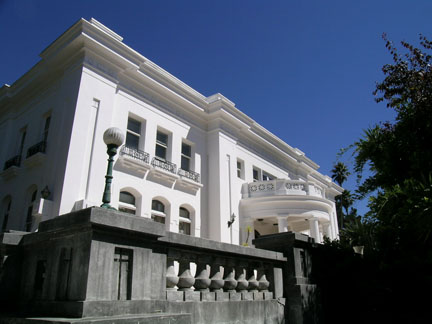Announcing our 36th Spring House Tour
and Garden Reception
Sunday, 8 May 2011, One to Five o’clock
Featuring houses by Bernard Maybeck, Edwin Lewis Snyder, Walter H. Ratcliff, Jr., John Hudson Thomas, Sidney & Noble Newsom, Joseph M. Walker, and Rowland & Rowland.
Tour map, illustrated guidebook & refreshments provided
General $40; BAHA members $30Order tickets online (see below) or use the ticket order form.
Tour-day ticket booth will open at 12:00 pm near the eastern gate of the Spring Mansion, 1960 San Antonio Avenue. The street will be closed to vehicles.
THE residential neighborhood gracing the rolling hills east of Arlington Avenue and above the Spring mansion is one of Berkeley’s most scenic early 20th-century garden suburbs. Tree-shaded streets are lined with picturesque period-revival houses reminiscent of Italian villas, Norman country houses, Tudor manors, and beguiling “storybook” cottages.
BEGINNING in 1909, John Hopkins Spring, owner and developer of most of what became Albany and North Berkeley, subdivided a succession of tracts, the first of which was Thousand Oaks, followed by Arlington Villa Sites (1910), Arlington Heights (1911), Arlington Oaks (1912), and Thousand Oaks Heights (1912). All these tracts were laid out by landscape engineer Mark Daniels, who worked in partnership with Vance Craigmiles Osmont, an expert in the volcanic rock so abundant in this area.
LIKE Spring’s other subdivisions, Arlington Heights boasts quiet, sylvan streets that undulate with the hills, sweeping marine vistas, generous lots, and secluded walking paths that provided easy access to streetcar lines, commuter trains, and ferries. Early residents of the neighborhood enjoyed a bucolic lifestyle within a 30-minute ride to San Francisco.
ALTHOUGH John Spring began construction on his own mansion in 1912, World War I delayed the full development of his tracts. Most of the lots in the Arlington subdivisions remained vacant until the 1920s, a boom decade in Berkeley, when the city’s population ballooned from 56,000 to 83,000. Much of that growth took place in hilly areas such as this one, which had streets and transportation lines ready for new homebuilders.
IN its architecture, Arlington Heights fully reflects the taste of the 1920s, favoring romantic styles imported from the not-too-specific past, be it European or American. Period revival was the order of the day: a fairytale Mediterranean past evoked by red tile roofs, rough stucco walls, towers, loggias, and sheltered courtyards; or visions of the English and French countryside, with extravagant half-timbering, turrets, and roofs made to look like thatch in slate or undulating shingles. While these motifs can be found all over the country, what sets the Berkeley version apart are the hillside setting and bay vistas, thanks to which these period-revival houses step down sloping, landscaped lots, opening up to the outdoors.
TO design their picturesque houses, homebuilders in Arlington Heights chose from a pool of talented local architects. Some, like Bernard Maybeck and Walter Ratcliff, were well established. Others were University of California graduates, including Edwin Lewis Snyder, Henry Gutterson, Roland Stringham, and the brothers Sidney and Noble Newsom (the latter John Spring’s son-in-law). Designer-builders such as Walter W. Dixon and R. K. Schmidt also left their mark. Daniels’ spacious lots, with their beautiful views and ample space for sheltered gardens, seemed to inspire the creativity that tourgoers will observe on the afternoon of May 8, as they amble among the picturesque hillside villas of Arlington Heights.
Pre-tour illustrated lecture
Storybook Style
Speaker: Daniella Thompson
Thursday, 5 May, at 7:30 pm
The Hillside Club
2286 Cedar Street
Berkeley 94709Lecture admission $15
Berkeley is a treasure trove of buildings that look as if they’d stepped out of a Mother Goose fairy tale. In the course of this illustrated talk, we’ll pay a visit to and marvel at the fanciful work of specialists in the whimsical genre that manifested itself during the 1920s.
Architects and builders who left their mark on Berkeley’s “Hansel & Gretel” architecture include William Raymond Yelland, Jack Thornburg, Francis Harvey Slocombe, Carr Jones, Sidney & Noble Newsom, and the Fox Brothers.
Editor of the BAHA website and author of the article series East Bay: Then and Now, Daniella Thompson will showcase both well-known and obscure examples of Storybook Style in Berkeley.
Order tour & lecture tickets online
(See instructions for using PayPal)
Or use the ticket order form to order by mail.
Tour docents receive complimentary admission to the tour.
To volunteer, contact BAHA.















